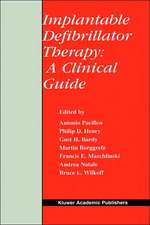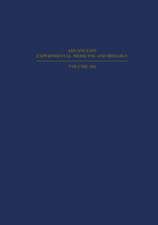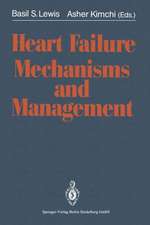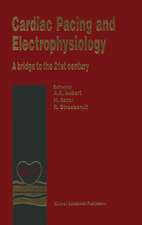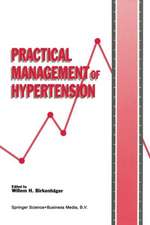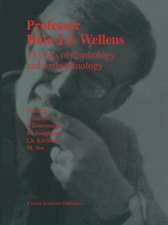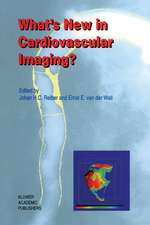Antiarrhythmic Drugs: Mechanisms of Antiarrhythmic and Proarrhythmic Actions
W. Haverkamp Editat de Günter Breithardt G. Hindricks Editat de Martin Borggrefe, John A. Camm, Mohammad Shenasaen Limba Engleză Paperback – 19 aug 2012
Preț: 722.69 lei
Preț vechi: 760.73 lei
-5% Nou
Puncte Express: 1084
Preț estimativ în valută:
138.28€ • 144.38$ • 114.45£
138.28€ • 144.38$ • 114.45£
Carte tipărită la comandă
Livrare economică 05-19 aprilie
Preluare comenzi: 021 569.72.76
Specificații
ISBN-13: 9783642856266
ISBN-10: 3642856268
Pagini: 424
Ilustrații: XII, 410 p. 300 illus.
Dimensiuni: 155 x 235 x 22 mm
Greutate: 0.59 kg
Ediția:Softcover reprint of the original 1st ed. 1995
Editura: Springer Berlin, Heidelberg
Colecția Springer
Locul publicării:Berlin, Heidelberg, Germany
ISBN-10: 3642856268
Pagini: 424
Ilustrații: XII, 410 p. 300 illus.
Dimensiuni: 155 x 235 x 22 mm
Greutate: 0.59 kg
Ediția:Softcover reprint of the original 1st ed. 1995
Editura: Springer Berlin, Heidelberg
Colecția Springer
Locul publicării:Berlin, Heidelberg, Germany
Public țintă
ResearchCuprins
Basic Mechanisms of Antiarrhythmic Drug Action.- Sodium Channel Blockade as an Antiarrhythmic Mechanism.- Pharmacology of T and L type Ca2+ Channels in Cardiac Tissue.- Molecular Biology and Ion Channel Biophysics: Their Role in Rational Pharmacological Antiarrhythmic Therapy.- Selective Pharmacological Modification of Repolarizing Currents: Antiarrhythmic and Proarrhythmic Actions of Agents that Influence Repolarization of the Heart.- A Shift from Class to Class III Drugs in the Medical Treatment of Arrhythmias: Wishful Thinking?.- Use Dependence and Reverse Use Dependence of Antiarrhythmic Agents: Pro-and Antiarrhythmic Actions.- Modulation of Antiarrhythmic Drug Action by Disease and Injury.- Interaction of Transient Ischemia with Antiarrhythmic Drugs.- Management of Patients with Sustained Ventricular Tachyarrhythmias: Differnt Clinical Studies, Different Patients.- Antiarrhythmic Drug Action: Modulation by Disease and Injury.- Reentrant Excitation: Pharmacological Interactions.- Pharmacological Modulation of Reentrant Excitation in Experimental Models.- Reentry in Clinical Arrhythmias: Mechanisms Responsible for Antiarrhythmic Drug Efficacy.- Variability of the Arrhythmogenic Substrate: Drug Influences.- Experimental Models for the Assessment of Antiarrhythmic and Proarrhythmic Drug Action: Traditional and Newer Models.- Influence of the Autonomic Nervous System on the Action of Antiarrhythmic Drugs.- Role of Drugs in Torsade de Pointes and Triggered Activity.- The Study of Pharmacokinetics and Pharmacodynamics as a Tool for Understanding Mechanisms of Antiarrhythmic Drug Action.- Electrophysiologic Effects, Clinical Efficacy and Antiarrhythmic and Proarrhythmic Effects of Sodium Channel Blockers in Patients with Ventricular Tachyarrhythmias.- Antiarrhythmic VersusProarrhythmic Effects of Class III Agents.- “Novel” Antiarrhythmic Drugs.- Electrophysiologic Properties and Antiarrhythmic Effects of Adenosine and Adenosine Triphosphate.- Magnesium-Electrophysiological Effects, Antiarrhythmic Properties and Clinical Applications.- Future Perspectives.- The Classification of Antiarrhythmic Drugs: How do we Educate the Scientist and the Clinician?.
Textul de pe ultima copertă
Management and prevention of tachyarrhythmias, especially of serious ventricular arrhythmias after myocardial infarction, is still a major problem. Large-scale evidence suggests an increased harm induced by antiarrhythmic drugs in the presence of organic heart disease although they effectively suppress spontaneous arrhythmias. This increased risk has been linked to their proarrhythmic potential and to possible interactions by ischaemia. However, the mechanisms by which antiarrhythmic drugs exert their antiarrhythmic and proarrhythmic actions are still poorly understood. Therefore, it was a time to present an update on the mechanisms of antiarrhythmic and proarrhythmic action of drugs which act on the electrophysiological properties of the heart. World renowned electrophysiologists as well as clinicians have joint to address important topics which range from the effect of antiarrhythmic drugs on single channels and on arrhythmia models to the clinical arena.


